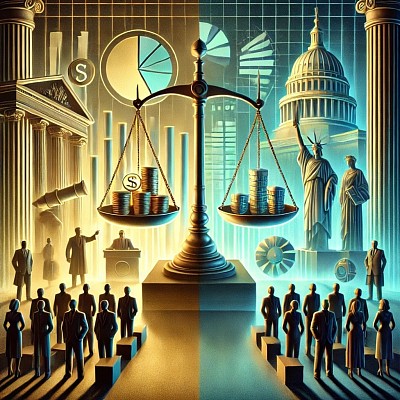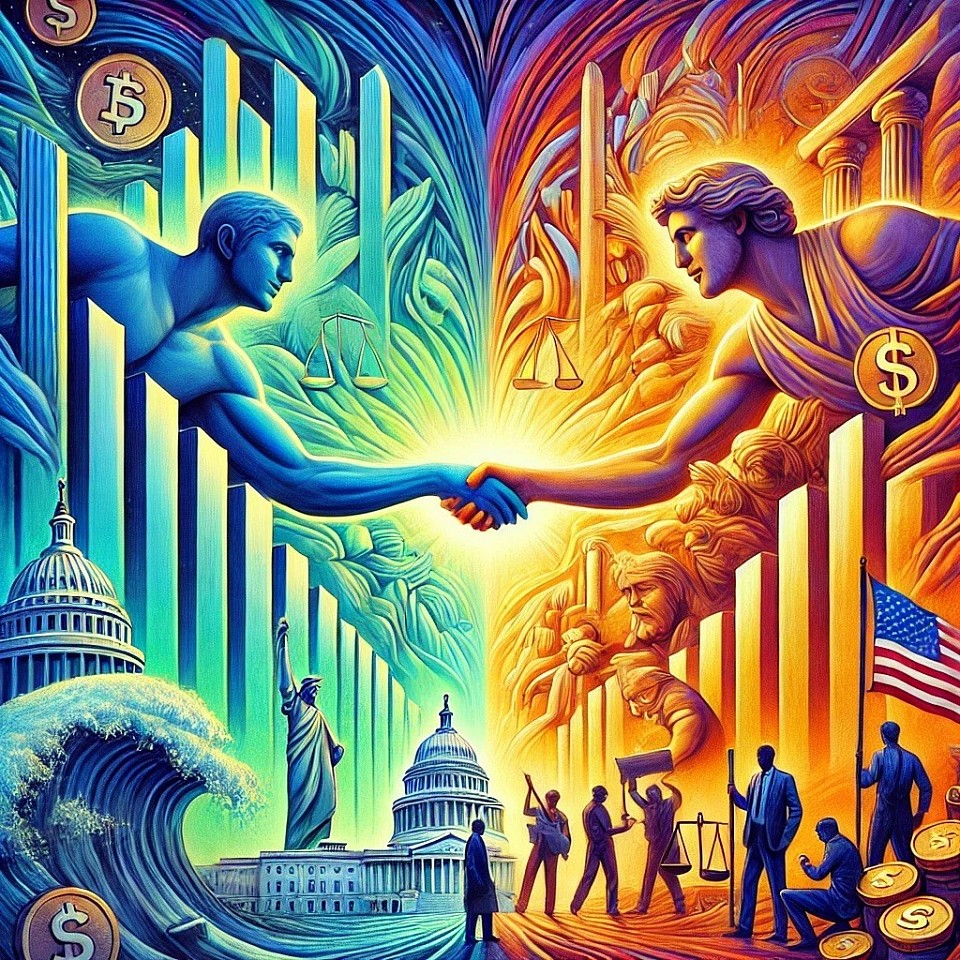Exploring Our Socio-Economic System
The Economic Vision of America’s Founding Fathers
The socio-economic system of the United States, as envisioned by its founding fathers, reflects an intricate interplay between capitalist principles and communist governance, resulting in a hybrid model that pits the elite minority of private capital owners against the elite minority in government. This dynamic tension has created the precarious balance that defines the American system.
While the founding fathers did not explicitly articulate this balance as capitalism vs. communism (concepts formalized later), they designed a system that inherently blended free-market economics with governmental oversight. This balance emerged as a way to:
- Protect individual freedoms rooted in capitalist ideals of private ownership and economic liberty.
- Prevent tyranny and unchecked power requiring a strong, centralized government as a counterweight.
Capitalism: The Engine of Economic Development
From the outset, the U.S. prioritized private property and individual enterprise:
Private Ownership: The founding fathers enshrined the right to own property as a cornerstone of liberty, ensuring that individuals could accumulate wealth through production, trade, and innovation.
Market Competition: A free market was seen as the best way to drive economic growth and individual prosperity.
Limited Regulation: Initially, the government maintained a laissez-faire approach to business, allowing capital owners to flourish with minimal interference.
The Capitalist Elite:
- Wealthy landowners, industrialists, and merchants became the first elite minority, controlling production and capital.
- Their wealth and influence enabled them to shape policies, often to protect their own interests.
Government’s Essential Role in Economic Management
To address the temptations of human nature that occur with the concentration of wealth and power in private hands, the founding fathers created a representative government tasked with managing public resources and promoting public welfare:
Checks and Balances: The U.S. Constitution established a system where government power was distributed among branches, ensuring no single entity could dominate.
Taxation and Public Services: The government was empowered to collect taxes and fund public resources like infrastructure, education, and defense, reflecting a proto-communistic approach.
Regulation: Over time, government oversight expanded to address market failures and protect workers, consumers, and the environment.
The Government Elite:
- Elected and appointed officials, bureaucrats, and judges formed another elite minority, wielding significant control over resource distribution and societal planning.
The Convergence of Capitalism and Communism
Over time, the balance of power between private capital and public governance in the United States has eroded, allowing financial influences to infiltrate government and align the interests of two elite groups: the capitalist minority (owners of production) and the governmental minority (policy-makers and regulators). This convergence has created a system where the majority—the working and middle classes—are systematically disenfranchised and exploited for the benefit of the elite few.
1. Financial Power: Shaping Political Landscapes
Campaign Financing and Political Dependency
- The Supreme Court’s Citizens United decision in 2010 allowed unlimited private influence in political campaigns, equating financial contributions with free speech.
- As a result, politicians have become increasingly reliant on funding from corporations, wealthy individuals, and special interest groups. This dependency ensures that policy-makers prioritize the interests of those wielding influence over the needs of their constituents.
Lobbying as a Tool of Influence
- Private interests invest billions annually in lobbying to craft laws and regulations that serve their agendas.
- A “revolving door” exists between government and private sectors, where former officials take lucrative lobbying roles, perpetuating cycles of influence and favoritism.
Privatization and Deregulation
- Public services like education, healthcare, and infrastructure have been increasingly subjected to private influence, transforming essential services into profit-driven industries.
- Deregulation, often framed as promoting efficiency, allows corporations to operate with minimal accountability, prioritizing profits over public welfare.
2. The Alignment of Minorty Interests
Shared Economic Goals: The capitalist elite and governmental elite share a vested interest in maintaining a system that preserves their wealth and authority.
- Corporate-State Symbiosis: Governments rely on private capital for tax revenue and economic stability, while private influencers depend on favorable policies and subsidies to maximize profits.
- Tax Policies: Wealthy private influencers push for tax cuts and loopholes that disproportionately benefit them, shifting the financial burden onto the working majority.
Mutual Power Consolidation
- Private influence drives governments to weaken labor protections, deregulate industries, and suppress worker power, consolidating control for both elites.
- Governments, in turn, protect private interests through subsidies, bailouts, and contracts, often at the expense of public investment.
Suppression of Labor Force
- Policies that undermine unions and collective bargaining benefit both elites by keeping labor costs low and workers disempowered.
- Globalization and outsourcing, often supported by government trade policies, exploit cheaper labor abroad while leaving domestic workers vulnerable.
3. The Exploitation of the Working Class
Economic Inequality
- Worker productivity has increased dramatically, but the profits of that labor are disproportionately captured by those wielding private influence, leaving wages stagnant.
- Wealth concentrates in fewer hands, while the majority face rising costs and limited economic mobility.
Burden of Debt
- The privatization of essential services like education and healthcare has left individuals burdened with debt, creating long-term financial dependence on entities influenced by private interests.
- Predatory lending practices ensure that cycles of debt persist, benefiting private influencers at the expense of the majority.
Erosion of Public Services
- Public funding for education, infrastructure, and social programs is deprioritized in favor of policies that cater to private interests.
- Working Class Communities face deteriorating services while privatized alternatives profit from their absence.
Political Disenfranchisement
- The influence of private interests ensures that policies serve the powerful rather than the majority.
- Voter suppression, gerrymandering, and systemic barriers further silence the voices of working-class citizens.
4. Mechanisms of Systemic Inequality in Society
1. Media Control and Narrative Framing
- Media organizations, often owned or influenced by private interests, shape public opinion to protect elite agendas while obscuring systemic exploitation.
- Divisive narratives distract the majority from uniting against shared economic and political oppression.
2. Consumer Dependency
- Overwork and consumer debt keep individuals focused on survival, leaving little time or energy to challenge systemic inequalities.
- A culture of individualism shifts blame onto individuals rather than addressing the structural causes of inequality.
3. Elite Collaboration
- Capitalist and governmental elites reinforce each other’s power: private influencers fund political campaigns, while governments enact laws and policies that protect their benefactors.
- This alignment transforms the government from a counterbalance to private capital into an enabler of exploitation.
The infiltration of private influence into government has allowed the interests of the capitalist elite and the governmental elite to align, creating a system that prioritizes profits and power over the needs of the majority. This convergence has undermined democracy, eroded public trust, and perpetuated economic inequality, leaving the working class to bear the weight of policies designed to benefit the few. Restoring balance and accountability requires systemic change to dismantle private influence and return power to the majority.
Discover Socialism
To understand the role of socialism in any socio-economic debate, it’s essential to focus on the distribution of power rather than just the distribution of means. What sets true socialism apart—especially from communism—is the absence of an elite minority. In true socialism, there is no ruling class or centralized authority dictating policies; instead, power rests with the people, who voluntarily cooperate as equals toward a common goal.
-
No Elite Minority: Unlike communism, which often centralizes power in a ruling government or planning committee, socialism thrives on horizontal power structures. There is no small group controlling resources or decisions; instead, power is distributed equally among participants.
- Voluntary Cooperation: True socialism is built on the voluntary cooperation of equals, not enforced mandates. Individuals freely choose to contribute to and benefit from the collective, ensuring that everyone participates willingly toward shared goals.
Any attempt to legislate “socialist policies” from the top down becomes communism, where a centralized planning authority enforces collective policy.
Socialism as the Third Leg of Our Socio-Economic System
In America, our socio-economic landscape has long been dominated by capitalism (private ownership) and communism (centralized governance). Adding socialism as a third leg to this system creates balance by redistributing power back to the majority—the laborers.
1. Returning the Power of Labor to the Laborers
- True socialism empowers workers to reclaim ownership of their labor, allowing them to decide how it is used, valued, and shared.
- This contrasts with capitalism, where labor is treated as a commodity, and communism, where labor is directed by a central authority.
-
Capitalism consolidates power among private owners, while communism consolidates it in the state. Socialism, by contrast, decentralizes power to the community level, ensuring that no single entity controls the system.
This decentralization creates resilience and prevents the abuses of concentrated power.
2. Focusing the Majority’s Collective Power
- With socialism, the majority class—comprising workers, families, and local communities—recognize that as the owners of means of production they are not at the mercy of elite minorities. The economy lives or dies by their efforts alone.
- This collective power allows laborers to resist the united efforts of the capitalist and governmental minority classes, who have historically aligned to exploit the working majority.
-
By allowing laborers to collectively manage their resources, socialism ensures that wealth and decision-making power remain with those who generate value.
This directly counters the strategies of elite minorities who rely on the disempowerment and division of the working class to maintain their dominance.
3. Restoring Economic Flow
- Capitalism’s “trickle-down economics” often concentrates wealth at the top, creating economic deserts for the working class.
- Socialism acts as an economic irrigation system, channeling resources directly to the majority through cooperation and shared ownership.
Through socialism, we can finally reclaim our rightful place as the true owners of our labor as a means of production, building a future that prioritizes equity, collaboration, and shared prosperity.




